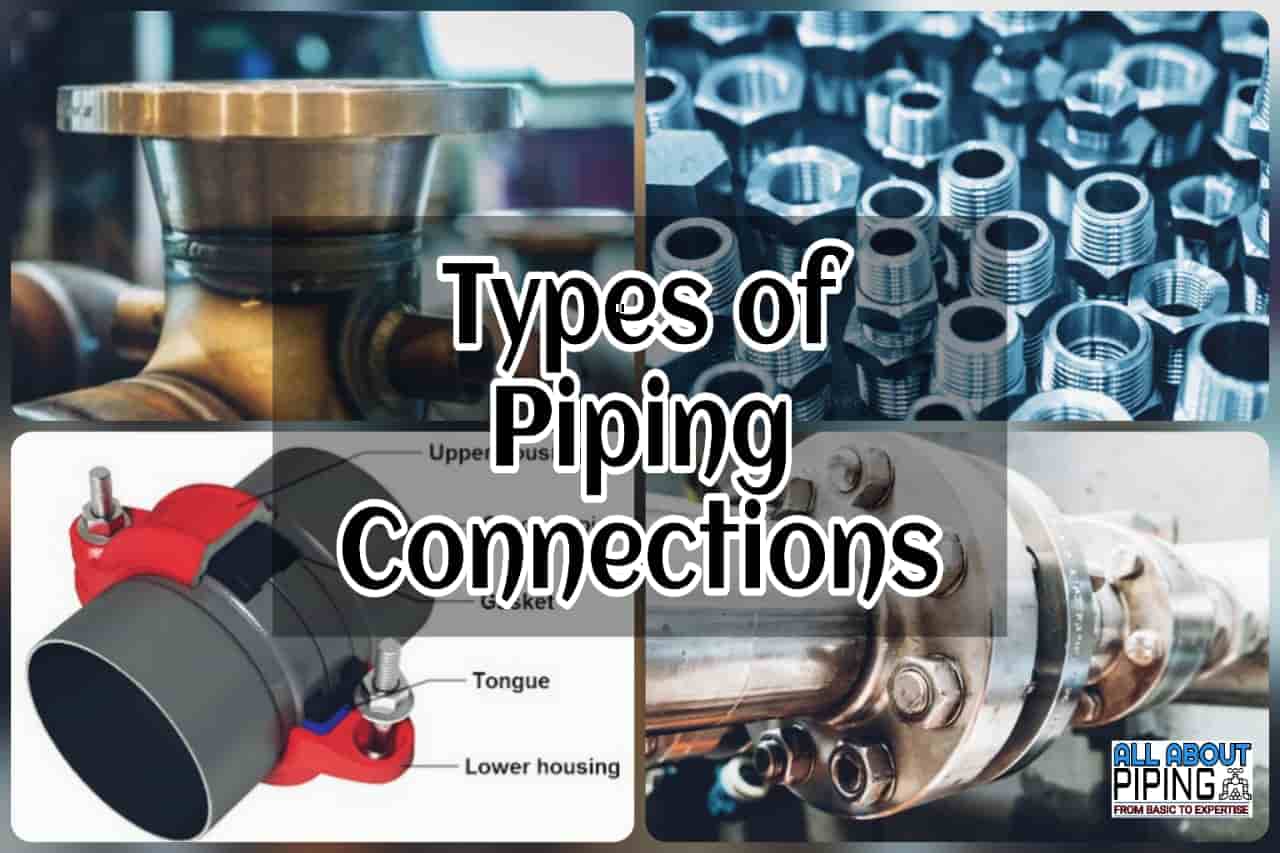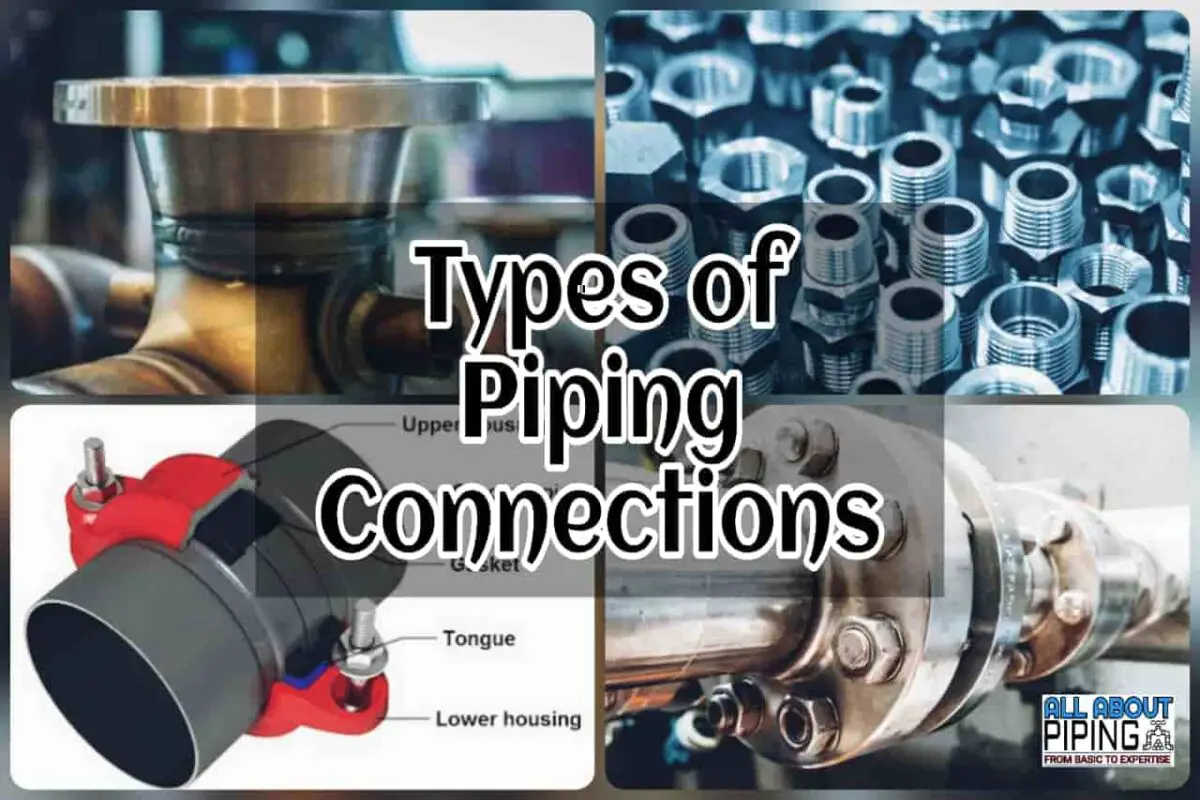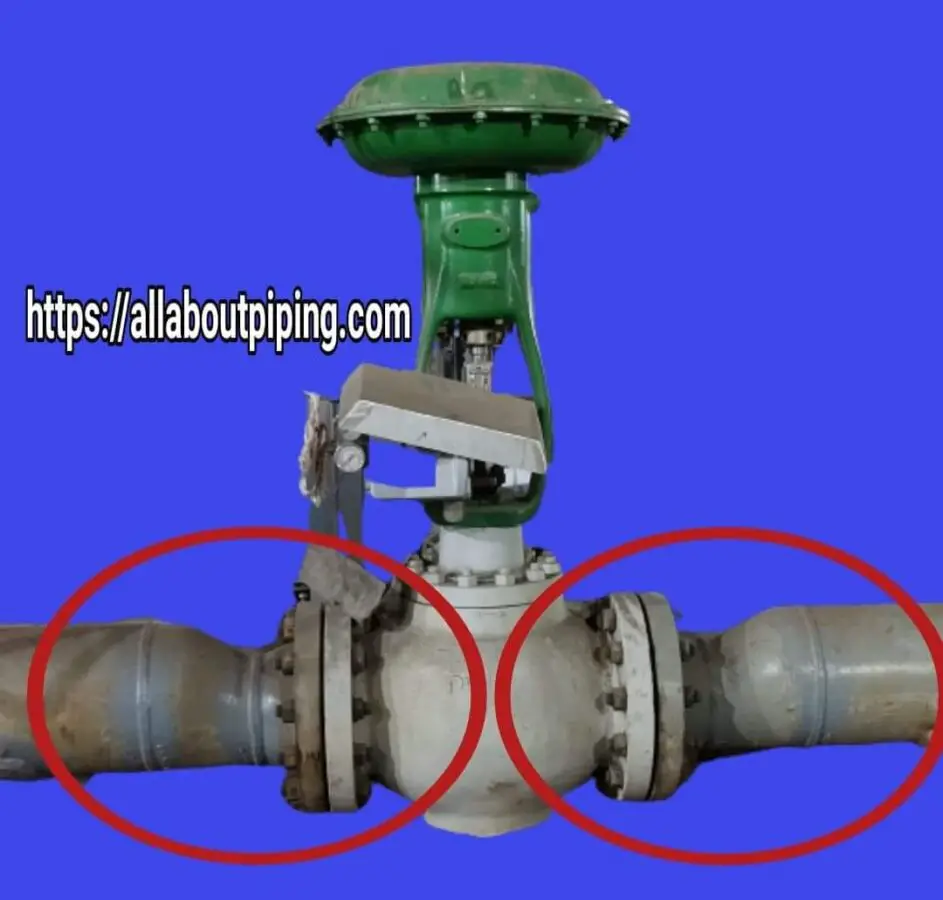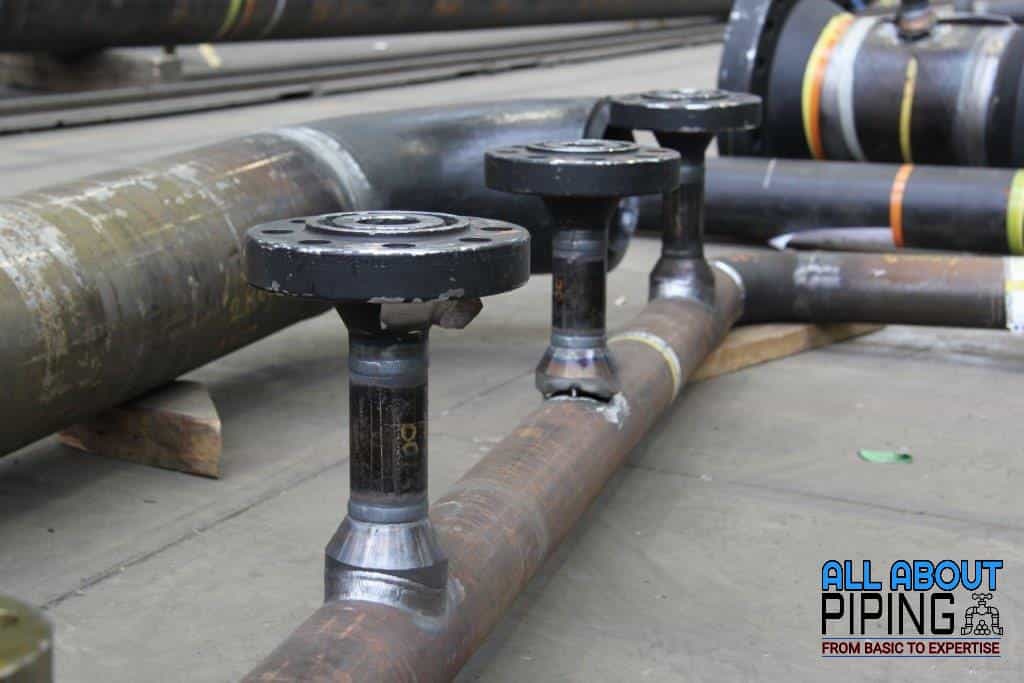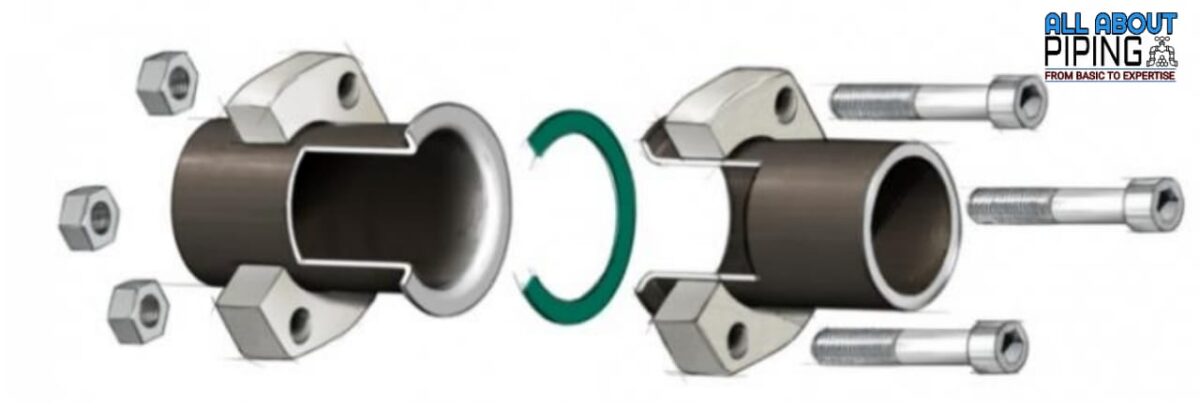Many time we need to develop a system to distribute fluid flow from one system to many others and sometimes from many pipes gets connected to a single header to generate high flow current. In all those situations choosing the best-suited connection for fluid flow is most important to handle fluid.
A well-chosen and designed pipe-to-pipe connection can lead to longer life of the piping network and efficient fluid flow. In this article, we will provide detail about types of pipe connections. Here you will learn about:
- Type of piping connections.
- Advantages and disadvantages of each type of pipe connection.
- Selection guide for the best suitable type of piping connection.
Featured Article: What is Branch connection in Piping? Types of Branch pipe Connection.
Table of Contents
Types of Piping connection
Knowledge and selection of the type of pipe connection are important. Pipe connection varies according to fluid type, pressure, temperature, and environmental conditions. The commonly used types of piping connections are:
- Flanged and bolted pipe connections
- Welded pipe connection
- Threaded pipe connection
- Grooved piping connection
More to Read: Heat Tracing in Piping: Types, Working, Use, Installation, Comparison
Flanged Piping connection
A flanged connection is one of the normally used types of piping connections. A flanged connection is a combination of 03 combinations like bolts, gaskets, and pipe flanges. This also depends on the temperature, pressure, and medium of a process system. A flanged piping connection is not a permanent connection.
In a flanged-bolted connection, all the various elements are interrelated and depend on each other to attain an efficient leakproof piping connection. The reliability of any flanged joint depends on components used in the joint-making process.
The main components of a flanged connection are:
- Flanges: These are pipe fittings that provide a base for flanged bolting piping connections. It is always used in pairs for making a flanged connection.
- Bolts: It is the component flanged connection that provides a compressive force on flanges by attaining a tension across its length. Bolt used can be of 02 types:
- Stud Bolt: These bolts are a combination of cylindrical threaded rod and 02 or 03 bolts. Both bolts are free to move from stud and provide well grip on studs.
- Machine Bolts: This type of bolt has a hexagonal head on one side of the threaded portion and free to move bolt on another side. Check nut and Washer can also be used here according to required.
- Gaskets: these are the components that provide a sealing action between the flanges. It gets compressed between flange faces. Gasket once used for flange connection should never be used to avoid leakage from flange joints.
Advantages of flanged type pipe connection
- Quick and easy for connecting pipe spool with respect to welding.
- Suitable to connect with equipment.
- easy to dismantle and assemble for maintenance purposes.
- A leak test is enough to ensure its reliability for leakage.
Disadvantage of flanged pipe connection
- Precise alignment between pairs of flanges required to avoid any leakage from the flange joint.
- damage gasket can be a reason for lack in the efficiency of joint.
- more costly compared to welded joint connections.
- Tensioning or torqueing required for making a leak-proof connection.
- Less effective in the piping system with vibration.
Welded piping connection
Welding in piping is a process where two faces of pipe edge are fused together by means of heat application. A complete welded joint can be referred to as a weldment. This is a permanent type of piping connection.
The welded joint is a direct connection between the pipe, the structure of welding is simple, beautiful, and tidy. With welding, we can save a large number of piping connection fittings. according to position and requirement a welding connection can be of the following types:
- Butt Weld: A Butt Weld is a circumferential welded joint connection, and the most common type of joint done in the fabrication of welded pipe systems.
- Lap Welding: A Lap Joint is formed when two metals are connected in an overlapping pattern on top of each other.
- Fillet Weld: Fillet welded joints such as tee, lap, and corner joints are the most common connection in welded fabrication.
- Edge weld: Edge welding Joints are normally applied to sheet metal parts that have end edges are placed at a location where a weld must be made to attach to adjacent pieces.
- Tee weld: Tee welding joints are formed when two members intersect at a 90-degree angle that makes the edges come together in the center of a plate or component.
Advantage of welded pipe connection
- Very less or no chance of leakage.
- less costly than a flanged connection.
- Easy to repair without any loss of piping fittings.
- Most effective in a piping system prone to vibration.
- Insulation wrapping is easy and requires less material.
- Space between two pipes can be minimized at an optimum level.
Disadvantage of welded pipe connection
- Required high skill for making a perfect weld joint.
- creates a heat-affected zone and can distort metal properties in the weld zone.
- Welded pipe connection does not allow any kind of expansion.
- Inspection work requires more time and accuracy.
Threaded Piping Connection
Threaded pipe connections are probably one of the oldest methods of connecting piping systems. Like socket weld fittings, threaded fittings are also used only for small pipe sizes. Generally, it is used for pipe sizes of 2″ NB or less.
Thread fittings are divided into 02 categories: Male and female. Male threads are found on the outside of pipe or fittings while female threads are found on the inside. More commonly, Male threads are referred to as MPT, and female threads are FPT.
Advantage of threaded connection
- Low cost and non-critical application.
- Installation productivity is comparatively higher.
- Leakage integrity is good for low pressure and low temperature.
Disadvantage of threaded connection
- A rapid change in temperature change can lead to leaks due to differential thermal expansion.
- Vibration can result in the failure of the threaded joints.
- For hazardous piping systems, threaded connections are not advised to apply.
- Only applicable of small bore pipe.
More Resources: What are High Point Vent and Low Point Drain? Why it is required?
Grooved Pipe Connection
Grooved piping connections are an assembly of housings, an elastomeric gasket, and Nut-bolts to joint grooved end pipes, valves, fittings, and equipment nozzles. The pipe grooves are made by cold forming or machining a groove into the ends of a pipe.
During connection, the gasket is positioned around the joint and housing placed over the gasket and this complete assembly are tightened with help of nut and bolts to secure housing together. After installation, The coupling housing engages the grooves around the circumference of the pipe to make a tight and leak-proof pipe connection.
advantages of Grooved pipe connection
- Ease in maintenance.
- Good bonding against vibration.
- Easy to align two ends of pipe or fittings.
- Takes less time to install and dismantle.
- Can handle expansion or contraction of pipe.
- Less total installation cost.
Disadvantage of grooved pipe connection
- This type of connection can not be used for high-temperature and high-pressure piping systems.
- The total weight of the piping system increases compared to welded pipe connections.
- if not done properly, the joint can lead to leakage.
- Not recommended for hazardous and vacuum piping systems.
More Resources: What Is RF Pad? How To Calculate Reinforcement pad dimensions?
Selection of Piping connection
Selecting type of piping connection with cost efficient and suitable for piping system depends on:
- Material of pipe
- Pressure and temperature of piping system
- Design and operation
- Safety requirement as per industry and process fluid
Before choosing the type of connection we must know the following thing related to the piping system in which this connection going to be used:
- Can it handle the pressure?
- Can it handle high temperatures?
- Does it have proven long-term performance?
- Are the joints or seals reliable?
- Can it be fitted properly?
- Does it have the confidence of manufacturers?
- Can it withstand the present environmental condition?
- Can it resist punctures and abrasion?
- Does it have widespread approval and acceptance from inspectors and engineers?
- Does it have quality and value?
- Is this cost-efficient for the life cycle of the connection type?
If most of the query results as “YES” than selecting that type of pipe connection will be useful for the system.
Conclusion
There are multiple types of piping connections available in industries. Using the most suitable connection type that makes the piping connection leakproof and cost-efficient is most important. Different types of pipe connection methods have different advantages and disadvantages.
While welded pipe connections are considered the most efficient threaded connections are only reliable for small-bore piping. The cost of each connection type also plays a vital role in the selection, Flanged type pipe connections are the costliest, and Threaded ones are low cost.
Comparing and selecting a proper connection type can provide long-term integrity and durability towards the “No leak” condition of piping.
